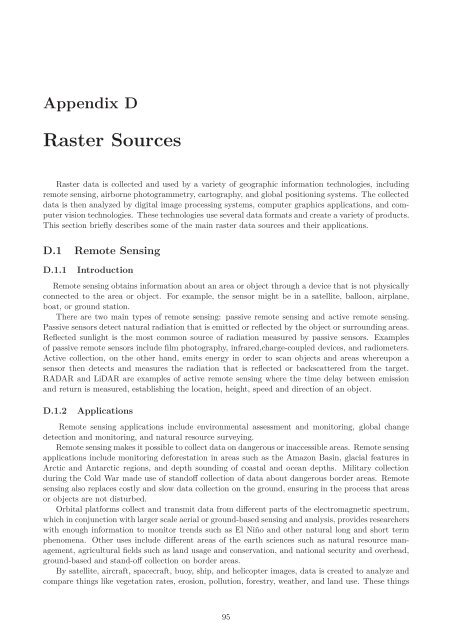PostGIS Raster : Extending PostgreSQL for The Support of ... - CoDE
PostGIS Raster : Extending PostgreSQL for The Support of ... - CoDE
PostGIS Raster : Extending PostgreSQL for The Support of ... - CoDE
You also want an ePaper? Increase the reach of your titles
YUMPU automatically turns print PDFs into web optimized ePapers that Google loves.
Appendix D<br />
<strong>Raster</strong> Sources<br />
<strong>Raster</strong> data is collected and used by a variety <strong>of</strong> geographic in<strong>for</strong>mation technologies, including<br />
remote sensing, airborne photogrammetry, cartography, and global positioning systems. <strong>The</strong> collected<br />
data is then analyzed by digital image processing systems, computer graphics applications, and computer<br />
vision technologies. <strong>The</strong>se technologies use several data <strong>for</strong>mats and create a variety <strong>of</strong> products.<br />
This section briefly describes some <strong>of</strong> the main raster data sources and their applications.<br />
D.1 Remote Sensing<br />
D.1.1 Introduction<br />
Remote sensing obtains in<strong>for</strong>mation about an area or object through a device that is not physically<br />
connected to the area or object. For example, the sensor might be in a satellite, balloon, airplane,<br />
boat, or ground station.<br />
<strong>The</strong>re are two main types <strong>of</strong> remote sensing: passive remote sensing and active remote sensing.<br />
Passive sensors detect natural radiation that is emitted or reflected by the object or surrounding areas.<br />
Reflected sunlight is the most common source <strong>of</strong> radiation measured by passive sensors. Examples<br />
<strong>of</strong> passive remote sensors include film photography, infrared,charge-coupled devices, and radiometers.<br />
Active collection, on the other hand, emits energy in order to scan objects and areas whereupon a<br />
sensor then detects and measures the radiation that is reflected or backscattered from the target.<br />
RADAR and LiDAR are examples <strong>of</strong> active remote sensing where the time delay between emission<br />
and return is measured, establishing the location, height, speed and direction <strong>of</strong> an object.<br />
D.1.2 Applications<br />
Remote sensing applications include environmental assessment and monitoring, global change<br />
detection and monitoring, and natural resource surveying.<br />
Remote sensing makes it possible to collect data on dangerous or inaccessible areas. Remote sensing<br />
applications include monitoring de<strong>for</strong>estation in areas such as the Amazon Basin, glacial features in<br />
Arctic and Antarctic regions, and depth sounding <strong>of</strong> coastal and ocean depths. Military collection<br />
during the Cold War made use <strong>of</strong> stand<strong>of</strong>f collection <strong>of</strong> data about dangerous border areas. Remote<br />
sensing also replaces costly and slow data collection on the ground, ensuring in the process that areas<br />
or objects are not disturbed.<br />
Orbital plat<strong>for</strong>ms collect and transmit data from different parts <strong>of</strong> the electromagnetic spectrum,<br />
which in conjunction with larger scale aerial or ground-based sensing and analysis, provides researchers<br />
with enough in<strong>for</strong>mation to monitor trends such as El Niño and other natural long and short term<br />
phenomena. Other uses include different areas <strong>of</strong> the earth sciences such as natural resource management,<br />
agricultural fields such as land usage and conservation, and national security and overhead,<br />
ground-based and stand-<strong>of</strong>f collection on border areas.<br />
By satellite, aircraft, spacecraft, buoy, ship, and helicopter images, data is created to analyze and<br />
compare things like vegetation rates, erosion, pollution, <strong>for</strong>estry, weather, and land use. <strong>The</strong>se things<br />
95
















